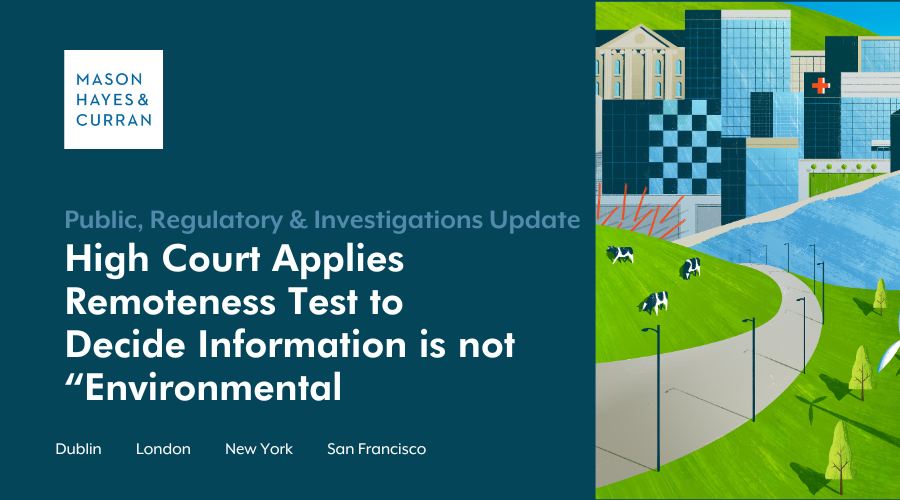High Court Applies Remoteness Test to Decide Information is not “Environmental"
AIE Update

A recent High Court decision demonstrates when information is “on” a measure which may affect the environment, or is too remote from the measure, in order to constitute “environmental information” under the AIE Regulations. Niall Michel, Public, Regulatory & Investigations partner, explores the impact of this decision for relevant organisations.
Public authorities often wrestle with whether information, which may not be intrinsically ‘environmental’, qualifies as “environmental information” accessible under the AIE Regulations. This is because the AIE Regulations define “environmental information” broadly. The definition is wide enough to cover information which is not directly on the environment, but is on a “measure or activity” which is capable of affecting the environment, or which is integral to another measure capable of affecting the environment. The question in these cases is whether the ‘non-environmental’ information is information “on” the relevant measure or activity, and therefore environmental information accessible under the Regulations, or whether it is too remote to be considered as such. Among other things, the recent High Court decision in ESB v Commissioner for Environmental Information & Others[1] reviews the case law on how to determine this question, and gives a good demonstration of its application in practice.
Background
This case involved the Electricity Supply Board (the ESB) and an electricity line-placement project. Under section 53 of the Electricity (Supply) Act 1927, the ESB may serve notice of its intention to enter a landowner’s land to lay an electricity line that has been decided on. The legislation states that after the notice has been served, it may do so with or without the landowner’s consent. This is subject to the landowner’s entitlement to be paid compensation. In the absence of agreement, the compensation payable to the landowner is assessed under the Acquisition of Land (Assessment of Compensation) Act 1919. This legislation provides for referral to, and determination of the amount of compensation by, a property arbitrator. In this case, Mr and Mrs Murphy made a claim for compensation under section 53 of the 1927 Act, following the exercise by the ESB of these compulsory powers on their land. The matter was referred to a property arbitrator. Following this, a hearing was conducted during which the parties made their arguments. A 488-page stenographer’s transcript was prepared, recording those arguments, but not the subsequent determination of the arbitrator.
Request for transcript
Under the European Communities (Access to Information on the Environment) Regulations 2007 to 2014, (the AIE Regulations), Right to Know CLG (RTK) applied to the ESB to be provided with a copy of the transcript. It contended that the entirety of the transcript constituted “environmental information” because it was “information on land and measures affecting or likely to affect land (i.e., development of electricity infrastructure)”.
Paragraph (c) of the definition of “environmental information” in the AIE Regulations, and in the EU Directive they transpose (Directive 2003/4/EC), provides that it includes “information … on … measures (including administrative measures) such as policies, legislation, plans, programmes, environmental agreements, and activities affecting or likely to affect the elements and factors referred to in (a) and (b) as well as measures or activities designed to protect those elements …”
Apart from claiming exemption under Article 9(1)(d) on the basis of adverse effect on the stenographer’s copyright rights, ESB refused access to the transcript on the basis that it was not entirely comprised of “environmental information” and was not information “on” the measure or activity comprising the line-placement project, as claimed. Rather, it contained information on a compensation process that post-dated the decision to place the electricity line. ESB also took the view that the transcript was solely concerned with what amount of money was to be paid to the landowners by way of compensation, and could not impact upon or determine any aspect of the project.
RTK appealed to the Commissioner for Environmental Information, who held in favour of RTK. The ESB then appealed to the High Court, which upheld its appeal.
Detailed assessment
In a detailed judgment on this point, the Court conducted a forensic and extensive analysis of whether the transcript of the compensation hearing could be said to contain information “on” the measure or activity capable of affecting the environment, in this case the line-placement project. Mr Justice Heslin concluded that it could not.
The Court noted the following propositions from previous case law:
- Information does not need to be intrinsically ‘environmental’ in nature before it is considered “environmental information”. (Department for Business, Energy and Industrial Strategy v. Information Commissioner & Henney)[2]
- The Regulations do not give a general and unlimited right of access to all information held by public authorities which has a connection, however minimal, with one of the environmental factors mentioned in the definition of “environmental information”. (Glawischnig v Bundsminister für soziale Sicherheit und Generationen)[3]
- A literal reading of paragraph (c) of the definition of “environmental information” would mean that any information about a relevant “measure” would qualify, even if the information itself could not be characterised as having, even potentially, an environmental impact. The mere fact that a project has some environmental impact does not mean that all information which is in some way related to the project must necessarily be environmental information. (Henney)
- A measure is “likely to affect” the environment, for the purposes of paragraph (c) of the definition of “environmental information” if there is a real and substantial possibility, rather than a probability, that it will affect the environment, whether directly or indirectly. (Redmond v. Commissioner for Environmental Information)[4]
- Information about a measure that is not itself the measure that is likely to affect the environment may yet be considered to be “on” the ‘ultimate’ measure. This is where the information can nonetheless be described as being about the ‘ultimate’ measure because it is about something that is integral or critical to the success of, and not merely an incidental aspect of, that measure. In assessing this, one must conduct a purposive but not overly expansive reading of the Directive and Regulations, and have regard to the specific facts and context of the particular case. (Henney)
Judgment
The Court noted the parties’ agreement that the line-laying project was a “measure” capable of affecting the environment. However, it found that (i) the Murphys’ compensation claim post-dated the decision to lay the electricity line (and necessarily did so); (ii) the line-laying measure was in no way dependent on the compensation claim; and (iii) it could never be said that, had it not been for the Murphys’ compensation claim, which post-dated all relevant planning and other decisions, there would be no electricity infrastructure project.
Whilst landowners enjoyed a right to compensation, and compensation was an integral part of the legal landscape of line-placement projects, it was also clear that the compensation hearing to which the transcript related was merely an “incidental aspect” of the line-placement project. This was the case because:
- No such hearing was inevitable, as compensation might not have been pursued, and
- Compensation might equally have been agreed without resorting to arbitration.
Therefore, the compensation hearing to which the transcript related would not even, at “first blush”, meet the “on”-test that is articulated in the case law.
Accordingly, all planning and related decisions concerning the infrastructure project had already been made before the arbitrator conducted the compensation hearing, in an “entirely distinct process”. The project went ahead on foot of decisions in which the arbitrator had “no hand, act, or part”, and “had no jurisdiction to decide, and was not asked to decide”.
The Court also found that the transcript was not information “on” the measure because it said nothing about:
- What compensation was payable
- What evidence or submissions, including regarding adverse effect on the land, the property arbitrator did or did not accept or rely on, and
- What approach the property arbitrator adopted regarding the compensation to be paid.
Conclusion
This decision will be of practical assistance to public authorities seeking to draw the correct dividing line between information which is “on” measures or activities capable of affecting the environment, and that which is not. It summarises the conceptual framework applicable to this exercise, the legislation, the case law and the principles involved. It also gives a practical demonstration of how to apply that framework to a particular case, and of the legal and factual aspects public authorities might need to identify to reach the correct conclusion.
The decision contains other findings against the Commissioner concerning his misapplication of the legal test for the applicability of the intellectual property exemption in Article 9(1)(d), his failure to give reasons for his decision to reverse a previous Article 9(1)(d) decision in favour of the ESB on the same transcript, and his failure to give adequate reasons for conclusions, including why he felt, against the legal and factual matrix involved, that access to information about the arbitration procedure might contribute to the public’s ability to participate in debate concerning future projects.
For more information on the impact of this decision on your organisation, please contact a member of our Public, Regulatory & Investigations team.
The content of this article is provided for information purposes only and does not constitute legal or other advice.
[1] [2024] IEHC 17
[2] [2017] P.T.S.R. 1644, [2017] EWCA Civ 844 (“H”)
[2] Case C-316/01) EU:C:2003:343)
[4] 2021] 3 I.R. 695, [2020] IECA 83 )
Share this:




